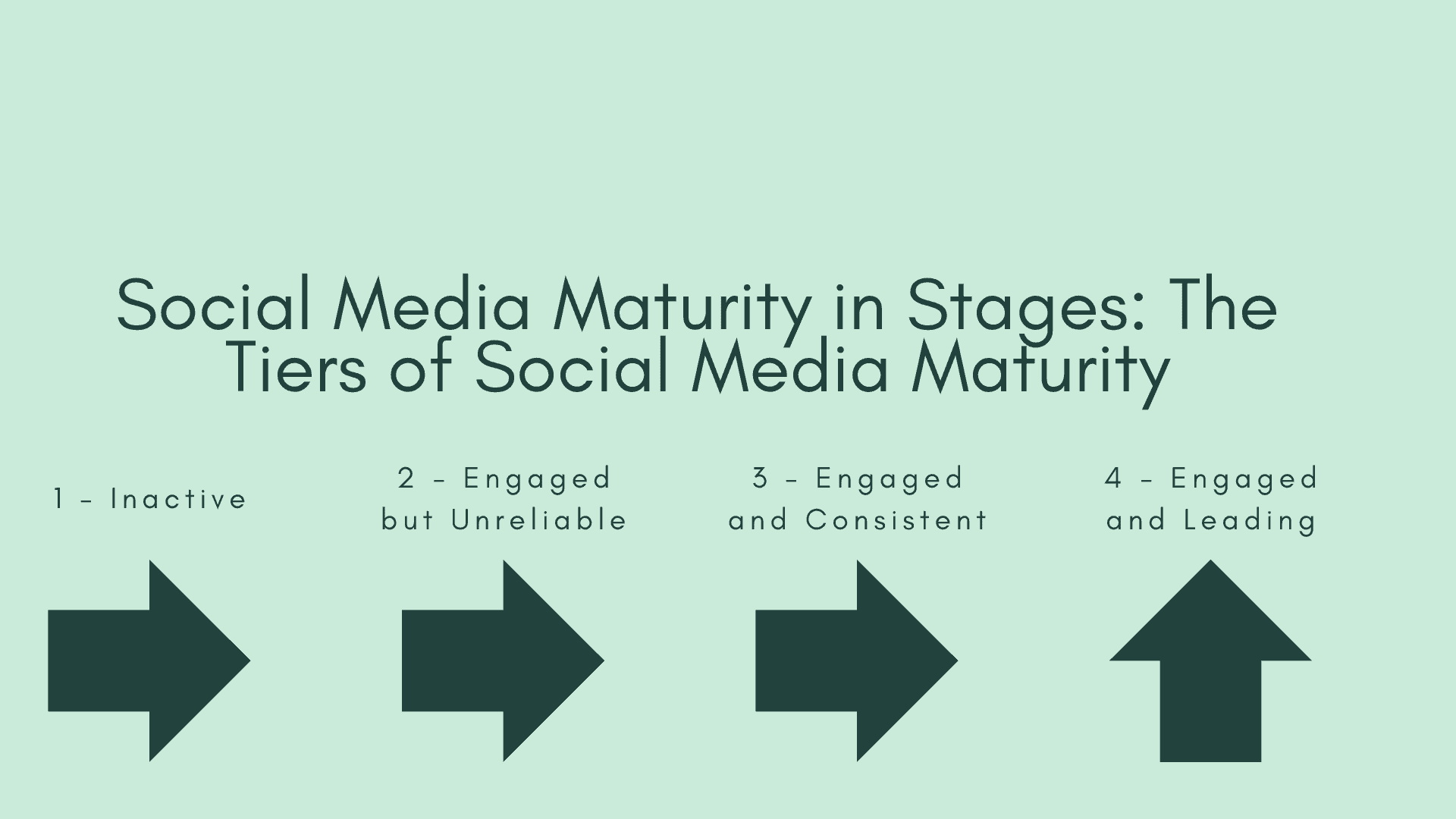Social media has become a daily part of modern life. People use popular social apps every single day – Facebook, Instagram, Snapchat, TikTok, and more – and connect with others across the world.
Businesses also use these platforms as an opportunity to engage with potential customers. In many cases, this is done as direct ads or sales-focused posts, but some brands use social media to create meaningful bonds with their audience and to strengthen their brand identity.
Social media maturity ensures your brand uses these powerful platforms as tools for more than just sales-based marketing, but as an extension of your brand’s identity. How can we go about expanding efforts to generate better engagement, though? Let’s find out.
What is Social Media Maturity?
If you leverage social media as one of your main business communication tools, you’ll need to learn about social media maturity. This is the process of changing how your business sees and manages the social media channel.
Much in the way a company needs to change internal policies, sales strategies, and marketing tactics as it grows, the approach to maintaining and fostering growth across social platforms needs to change, too.
This will take many forms, and the specifics of how a business can mature its approach to social media marketing will be discussed later. But is the possible payoff worth the resource investment?
It undoubtedly is. Data shows that the average amount of social media usage per day has risen from 90 minutes in 2012 to over 140 in 2024 – that’s almost two and a half hours every single day.
Every moment someone spends on these platforms being marketed to by your competitors only hurts your chance for a sale.
Further to the issue of loss of revenue, a lack of social media engagement opens your brand to unwanted conversations and dialogue. If you have no voice, you can’t participate – it’s that simple.
Your social media presence ensures you can control the conversation and steer it in ways that benefit your brand and promote the values important to you.
Keep in mind that the tactics that work as an agile ten-person team with a core product focus will not scale to an international organization that operates in many verticals.
The need to mature a strategy will scale not only with size but with operational complexity and your marketing ambitions.

Image sourced from Statista
Social Media Maturity in Stages: The Tiers of Social Media Maturity
Social media maturity is a long process that requires you to build on stable foundations and commit, as a team, to genuine growth.
We’ve broken down the minutiae that can help signify a brand’s social efforts into four easy-to-digest tiers – inactive, engaged but unreliable, engaged and consistent, and engaged and leading.
These stages represent a large umbrella that encompasses typical activities we recommend a brand do to achieve. Let’s take a closer look at each one of them.
Level 1: Inactive
This is where a fresh business and any business that has yet to work on its social channels will begin, most notably in business-to-business verticals where social media is discounted as a strategy.
Fundamentally, there are no ‘requirements’ to reach level one, and we should aspire to rise above this level as quickly as possible.
Level 2: Engaged But Unreliable
At this stage, businesses will have opened channels of communication with an audience and will be thinking about social media as part of their marketing strategy. Posting may be inconsistent across the various platforms and a broader strategy may yet to be in effect.
While there may be account managers, it’s also possible to operate a social platform with a democratic approach – multiple team members posting as they deem appropriate. Furthermore, the brand voice may be outlined formally or delivered inconsistently.
Here are the steps to move from level one to two:
- Have all target platforms configured and live
- Identify a select number of employees to take on the responsibility
- Explore your brand values and translate them into the brand voice
- Post relevant content that reaches target audiences
- Start performing basic tracking

Free to use image sourced from Pexels
Level 3: Engaged and Consistent
Brands that operate at this tier will have an established social media presence, a proven track record of outputting content consistently and to a certain quality, and metrics proving engagement from their audience.
At this point, a brand will have set managers to strategize content delivery and will be operating alongside other channels to create better and more effective campaigns. Furthermore, the brand voice will be well outlined and in effect across each social media platform.
The steps to reach level three are as follows:
- Establish a social media policy for employees to abide by
- Establish a concrete set of brand values and a tone of voice for platform engagement
- Create a consistent stream of quality content of various styles
- Track metrics on user behavior and reception to social activity, as well as any revenue generation through social channels
- Maintain a content calendar that keeps up with trends and industry changes
Level 4: Engaged and Leading
At this stage, your company is ever present in the social conversation and has showcased a clear superiority over the competition.
Meaningful performance is delivered through social channels, and you have a team of dedicated social media managers who keep a pulse on the social community.
Your brand voice will be solidified and recognizable by an audience and distinct from competitors’ approaches. Automation will be at the heart of day-to-day operations, allowing your social media team to operate at a strategic level and drive the brand forward.
A business operating at this level will need to:
- Have an industry-leading approach to social content creation
- Support and foster a growing captive audience that aligns with your values
- Leverage advanced metrics to dive into performance and improve strategy
- Implement in-depth automation processes to support long-term delivery
- Drive initiatives and empower wider business objectives through cross-channel and cross-department integration

Image created by the author
While these tiers provide a grounding to assess your business’s social media activities, the reality is that most organizations will operate across the entire spectrum. But how do we go about maturing our approach to social media management? Let’s dig in.
How to Level Up Your Brand’s Social Media Maturity
In this section, we will break down the key strategies you need to employ to bolster your social presence and outpace the competition.
While there are many layers to a successful social media presence not covered here, we’ve chosen the critical elements that will set your brand up for success.
Pick Your Platforms and Set Up Account Managers
The first step is to establish the platforms you’ll operate in and designate account managers for those platforms. It might seem smart to just create an account on every possible platform and cross-post your content for the biggest impact with the least investment.
Unfortunately, not all content works for every platform and you’ll only harm your efforts by trying to fit square pegs in round holes, so to speak.
Popular platforms to pick from include:
- Facebook – the de facto social engagement platform that has a wide reach and a wide range of communication features
- Instagram – a visually-focused subsidiary platform of Facebook that focuses on content delivery over conversation, including multiple forms of content such as Instagram stories
- TikTok – a video platform that focuses on unique algorithms to create virality
- Snapchat – a visual platform that uses transient posts as the primary form of communication
- X (formerly known as Twitter) – a conversational platform that is often used for large-scale announcements and news
- LinkedIn – a comms platform focused on B2B interaction
- Reddit – a community-based platform that encourages in-depth discussions
- Discord – a siloed platform that has risen to prominence for its ability to foster moderated communities away from typical social engagement
Given the difference in each social media platform, you will want to choose several to focus your efforts on and manage them effectively over spreading your team too thin.

Free to use image sourced from Pexels
Design a Social Media Policy to Align All Social Engagement Guidelines
A social media policy serves as your ‘rulebook’ for handling all manner of social activity across platforms. With this documentation, your team can maintain social platforms with greater confidence.
Specific protocols will be established when handling the various aspects of social media platform management, including direct customer engagement, safeguarded topics, posting guidelines, and legal definitions that protect your business.
Solidify Your Brand Voice
Your brand voice is a direct translation of your business’s identity, values, and ambitions, and is a key part of building a stronger social strategy.
Without a unifying set of values to bring each targeted platform together, communications can become scattered and will create conflicting scenarios for your business.
Your brand voice extends beyond the words and written content you output. It covers all aspects of your brand’s identity, including color palettes, visual identity, operational values, and much more.
Your social media team needs to have the right information to effectively create content and engage with your audience.
If you’re struggling to nail down your brand voice, research your competitors – see what works, what values resonate with customers, and establish how you can go above and beyond.
Done effectively, your brand voice can be one of the most powerful marketing materials available to a brand. Looking at Apple as possibly the best example of brand identity at play, we could quite literally remove the product names from the image below, and many people would still recognize this as Apple communication.

Screenshot sourced from Apple
Establish Your Technology Stack – Automation and Tracking
As your maturity grows and the workload to manage each platform increases, you’ll become aware of automation and the benefits it can provide.
We recommend exploring the options available to your business, as well as the resources required to manage it and weigh up if you’re at the stage where website tracking tools and automation will be of assistance.
Contrary to this, we strongly believe that all social campaigns need effective tracking and monitoring to perform their best. Without tracking in place, your content and strategy are based on intuition alone – not a real recipe for success, unfortunately.
Quality data can inform your social team on what works and what doesn’t with your audience, helping to improve future communications and get the best outcome for your brand.
Create Content That Caters to Each Platform and is Meaningful to Your Audience
The idea of designing a single piece of content for multiple platforms sounds great on paper, but in many cases, it doesn’t translate effectively. Each platform has unique demands and ‘metas’ that dictate what works and what doesn’t.
For example, Reddit is quite accustomed to long-form content that dives deep into a topic, while Instagram and TikTok enjoy short-form video and image content that grabs users’ attention. You need to tailor output to each platform and monitor reception to get the best results over time.
There are instances where content can cross between platforms, and when possible, it is worth doing. Just don’t expect every piece to be suitable.

Free to use image sourced from Pexels
Create a Social Media Calendar to Coordinate With Other Departments
A content calendar provides a reliable source of truth for all social activity, ensuring that your various platforms are working in concert to deliver the best results.
Content can be staggered as part of wider campaigns and can be orchestrated to launch alongside other marketing or product initiatives, leading to better integration and stronger results.
The Next Steps
Wherever you are in your social media journey – from half-forgotten accounts with little engagement to a multi-platform strategy pushing fresh content daily – it is worth reflecting on your current position to gauge your social media maturity.
Even the most well-oiled machine can be optimized further, and no campaign can be perennially successful.
Building a high-performance social strategy takes time and dedication to achieve, and you’ll need the right team to back your ambitions. Follow the tips in this guide to give your team a solid footing when embarking on this fruitful journey.


